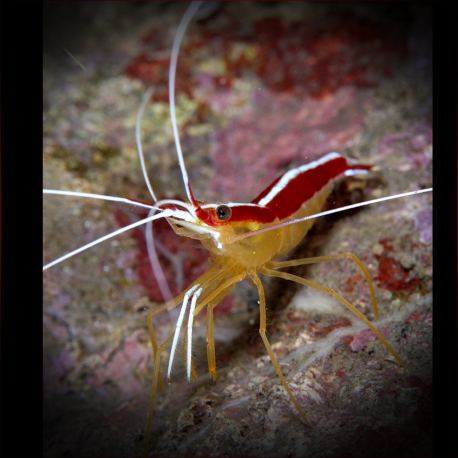More info
Datasheet
| Minimum Tank Size | 50 litres / 13.21 US gallons |
| Maximum Size | 5.0cm / 1.97inches |
| Reef Compatible | Always reef safe |
| Temperament | Peaceful |
| Temperature | 22.2°C / 71.96°F - 25.6°C / 78.08°F |
| Specific Gravity | 1.020-1.025 |
| Carbonate Hardness | 8-12 |
| pH | 8.1-8.4 |
General Description
Lysmata grabhami, commonly known as the Caribbean cleaner shrimp, can be identified by the solid white stripe running from the head to the tail, with stripes along each outer edge of the tail. Belonging to the Alpheoidea family, these shrimps play various roles in aquarium ecosystems, such as removing parasites and contributing to overall tank cleanliness.
Aquarium Suitability
With an average hardiness level and a peaceful temperament, L. grabhami is suitable for most aquarium setups, making them a popular choice among hobbyists. They are known to be reef safe and contribute positively to the overall health of the tank.
Demands, Care and Hardiness
These shrimp have average hardiness and can be sensitive during transportation and acclimatization. They require a tank size of at least 50 liters and specific water conditions with pH ranging from 8.1 to 8.4, alkalinity between 8-12 dKH, and a salinity level of 1.020-1.025.
Reef Suitability
L. grabhami is known to be reef safe and can coexist peacefully in a reef environment without causing harm to corals or other inhabitants.
Aquarium Setup
For optimal care, provide a tank with suitable hiding spots, live rock for grazing, and gentle water flow. Maintaining stable water conditions and offering a varied diet is essential for their well-being.
Behaviour
These Caribbean cleaner shrimp exhibit peaceful behavior in the aquarium and can be observed diligently cleaning themselves and other tank mates.
Feeding and Diet
They primarily feed on detritus and parasites, making them beneficial for maintaining the overall health of the aquarium. Their diet can include small crustaceans like krill, mysis, and artemia.
Habitat and Distribution
Found in the Mexican Gulf and West Atlantic, L. grabhami inhabits a variety of marine environments, contributing to the ecosystem by removing parasites and detritus. They are known to be bred in captivity, offering a sustainable option for aquarists.

